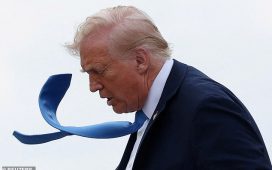Unlock the White House Watch newsletter for free
Your guide to what the 2024 US election means for Washington and the world
Gold has become the best performing “Trump trade” in recent weeks, outperforming other major asset classes since the US President’s inauguration, as fears of a trade war and a potential hit to global growth fuel demand for the haven metal.
Bullion has risen in price every week this year as Trump starts to impose sweeping tariffs, and hit a new record of $2,942.70 per troy ounce this week. It has surged almost 7 per cent since before the January 20 inauguration despite slipping on Friday.
In contrast, Wall Street’s S&P 500 stocks index has risen less than 2 per cent, while other popular Trump trades such as bets on a stronger dollar, higher Treasury yields or bitcoin have backfired.
“When trade contracts, gold takes off,” said James Steel, precious metals analyst at HSBC, pointing to previous examples during the Covid pandemic and the global financial crisis.
“The more tariffs that go on, the more this is going to disrupt world trade, and the better it will be for gold,” he added.
The bullion rally has been supercharged by a growing stockpile in New York, which has grown 116 per cent since the election, as traders and banks rush to move gold out of London, the biggest physical trading hub, and into the US. That has created a weeks-long queue to withdraw gold from the Bank of England vaults.
Trump’s latest tariff salvo includes a plan to introduce “reciprocal” tariffs on US trading partners, including both allies and adversaries. He has also imposed additional 10 per cent tariffs on goods from China.
Analysts say a global trade war will depress economic growth and fuel inflation — factors that typically benefit bullion.
“Gold is a Trump tariff trade,” said Nicky Shiels, an analyst at MKS Pamp, a gold refiner. “There is positive correlation between tariff headlines and gold prices moving higher,” she added.
While gold has continued its long rally, other Trump trades have lost money. The dollar has slipped 2.4 per cent this year against a basket of other currencies and has fallen sharply since the inauguration. Ten-year US Treasury yields, which rose to just over 4.8 per cent last month, have since fallen back to 4.48 per cent as the price of the debt has recovered.
Traders and investors say a more gradual approach to tariffs than previously feared has lifted the currencies of countries or regions with large exports, such as the euro. Meanwhile, the shift in the market’s focus to the risks to growth from a trade war has driven investors to buy government bonds.
“Gold can act as a geopolitical hedge, an inflation hedge and a dollar hedge,” said Trevor Greetham, head of multi-asset at Royal London Asset Management.
“It’s the first two that have made gold such a strong investment over the last year, with central bank and retail buying driving the price higher.”
The greenback’s recent decline has added to upward pressure on gold, which is priced in dollars, making it cheaper to buy in other currencies.
As gold has hit a series of record highs, some banks have already had to upgrade the price forecasts they set in December. Last week both UBS and Citigroup upgraded their target price to $3,000 per troy ounce.
This year strong buying from central banks, as they seek to diversify away from the dollar, is expected to be a key driver of gold demand.
Central banks bought more than 1,000 tonnes of gold last year for the third year in a row, according to data from the World Gold Council, an industry body.
Mark Bristow, chief executive of mining company Barrick Gold, said the “chaos across the globe” has helped fuel investor demand for gold as a safe haven.
“Very clearly the market is telling you there is only one reserve currency in this world, and that is the one politicians can’t print — and that is gold,” he said.








